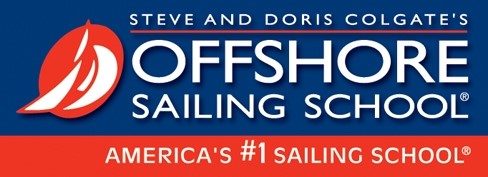Time spent on a boat consists of working with lines, pulleys, and wiring that surround the sailboat. On a sailboat, everything has a purpose, and these tools are what are known as sail controls. Sail controls help sailors capture the energy of the wind as efficiently as possible.
Sail controls are adjustments sailors make to change the shape of the sail, which allow for better control of the wind to steer the boat with precision.
The Importance of Sail Design
Before we dive deep into the sail controls, it’s important you understand the sail design or know how to ‘read sail shape’. Sail shape consists of the twist and draft.
The Draft
A sail has the characteristic curved shape, also known as the draft, to generate lift. When wind flows over the sail’s curve, it creates a difference in pressure, which causes the boat to move forward.
The more draft, or the deeper the curve of the sail, the more power to move the boat. Flatter sails indicate that there is less power.
The curvature of the draft is measured between the distance of these two points on the sail:
- Sailing Luff: the front or leading edge of the sail or the part that faces the wind first
- Sailing Leech: The leech is the back edge of the sail, it’s what sways in the wind.
The Twist
Twist is the difference in the angle between the sails’ luff and leech. To explain simply, the sail is twisting, and the top of the sail has a different angle than the bottom part, which helps it work in different wind speeds.
How do Draft and Twist Work Together?
The sail’s draft and twist work together to optimize the speed and stability of the boat. You adjust the sail’s shape—more draft and twist is best for light winds and less for strong wind conditions.
The simplest way to view them is:
- Draft: the more draft there is, the more power. If there’s less draft, there’s also less power.
- Twist: if there’s light air, more twist allows the top of the sail to catch more wind, thus more power. Less twist is better when there are high winds because it produces less power, allowing for more stability.
Therefore, the next question is, how do you adjust the draft and twist? The answer is with sail controls.
Fundamental Sail Controls
Fundamental sail controls are the mechanisms and tools used to help sailors adjust the shape and power of the mainsail. The main sail is the largest sail on the boat.
- If sailing upwind (against the wind), the best direction to sail is as close to the wind as possible.
- If sailing downwind (with the wind), your goal is to maximize speed and stability.
Failure to properly control the sails of the boat could result in a knockdown.
What’s a knockdown in sailing? A knockdown is when the sailboat is forced to rapidly turn 90 degrees due to strong winds causing the boat instability.
Mainsheet
The mainsheet is the rope (line) that controls the angle of the mainsail.
By pulling on the mainsheet, you can trim the sail (add tension) to reduce the power generated by the wind. You can also ease the sail (reduce tension) by letting the line out so the sail can fill up with wind and increase boat speed, maximizing the use of the sail area.
Traveler
The traveler is the rigging used to control the mainsheet. The traveler is fixed to a horizontal track on the boat which allows the mainsheet to move sideways. It’s a key tool to adjust the angle of the sail to the wind, helping control its navigation and stability.
Outhaul
The outhaul is a control line that pulls the bottom edge of the sail tighter. Think of it as tightening a sheet on the bed. This flattens the sail, thus reducing the power generated by the wind.
Cunningham
The cunningham is the line that adjusts the tension of the leading edge of the sail (the luff). Here sailors can adjust the draft to either increase or reduce the boat’s power.
Boom Vang
The boom is the long pole at the bottom that is attached to the mainsail. When the sail catches wind, the boom can rise up.
The boom vang is the rope that pulls down on the boom, preventing it from rising too high and risking instability. Therefore, the boom vang also helps control the shape of the sail and helps mitigate the power it generates.
How do Sail Controls Affect Sail Trim?
Altogether, these sail controls work to either create a flatter shape when going upwind or to depower the sail for easier control when going through heavy air.
Additionally, you can create a fuller sail shape by reducing the mainsail’s tension with the above controls to increase speed and power.
Here’s a cheatsheet we’ve provided for you to become more knowledgeable about these sailing basics:
|
Sail Control |
Upwind | Downwind |
|
Mainsheet |
Trimmed (tightened) |
Eased (loosened) |
|
Traveler |
Centered or slightly inboard |
Outboard (on the edge of the boat) |
|
Outhaul |
Tightened | Eased |
|
Cunningham |
Tightened |
Eased |
| Boom Vang | Tightened |
Eased |
With practice, these adjustments will become second nature, and you’ll be become better at recognizing the effects on sail shape to increase your confidence in the water.
Where can I learn Sail Controls?
Offshore Sailing School has more than sixty years of experience in teaching students in all levels of sailing mastery the art of using sail controls.
At Offshore Sailing School we offer a wide array of sailing and powerboat courses, from beginner to advanced.
Our Fast Track® Sailing Courses are an accelerated bundle of master classes designed to expedite your skills on small and large-sized sailboats, catamarans, and monohull yachts.
We’ve had the pleasure of working with more than 160,000 adults and their families, creating an honorable community of sailors. If you’d like to join America’s top sailing school, contact our certified sailing instructors to set up your first consultation!








